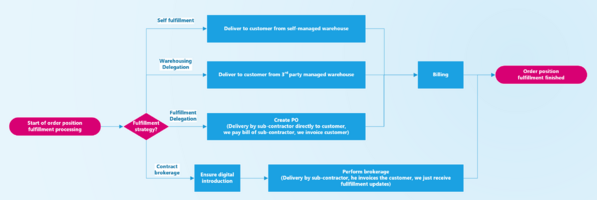Fulfillment
Fulfillment means all process to fulfill a promise given to a customer!
From a retailer`s perspective this means the activities performed once an order is received to fulfill the order: packaging, distribution and shipping of goods. From a logistic provider`s perspective it is the packaging and dispatching of a customer`s order. The digital which needs to fulfill typically promises certain goods by accepting an order - typically an internal order, customer order, returns order or relocation order.
Fulfillment Strategy on order position level
Once the promise is given to the customer, a decision for each order position has to be made: "How do we fulfill this promise?". This decision typically depends on various information like type of goods, goods availability, goods pricing, target region, required time of arrival at the customer or general fulfillment strategies. ZUGSEIL currently offers 4 fulfillment strategies:
- Self-fulfillment This is the default fulfillment strategy for most of the goods and does not require b-op based interaction of digitals. Goods are taken from local stock. If lock stock has insufficient stock measures are taken to refill it, so the goods can be sent to the customer. After being sent the customer is invoiced by the sent goods.
- Warehouse delegation (only available with inter-digital digitization) There exists a warehouse, which is under full control of the ordering digital, but is hosted at a 3rd party digital, the goods are shipped from that delegated warehouse. After the goods have been sent out the customer is invoiced by the sent goods. The participating digitals communicate on the shipment order and delivery order status.
- Fulfillment delegation (only available with inter-digital digitization) The entire fulfillment is outsourced to a 3rd party digital. The fulfillment of goods is placed as procurement order at the supplying digital. One the supplying digital confirms the delivery of goods to the final customer, he is invoiced by the sent goods from the 1st level supplier. The participating digitals communicate on the procurement order status.
- Contract brokerage (only available with inter-digital digitization) In this scenario, the digital which received the order is taking a brokerage role. It just informs the next level supplier that there is a customer which wants to order stuff with him at which conditions. At the same time it informs the customer which digital will take the offer for these conditions. The customer and the customer places a regular purchase order with the supplier. Once the contract is established the broker`s digital is notified that a contract has been successfully created and he might charge a commission for his services (over the backwards order process) with the customer. Please note that the digitals of the supplier and the customer have to know each other. Eventually the broker must make sure that the digitals are introduced beforehand!
Self fulfillment
Fulfillment Strategies enabled by b-op
Warehouse delegation
Fulfillment delegation
Contract brokerage
Fulfillment chains
Sometimes the fulfillment of a position include not just the mere shipment of a good but needs services to be applied to this product. In this scenario fulfillment chains can be used to apply services to a good. ZUGSEIL is not limited to service chains inside the supplier`s digital but also allows 3rd parties to be included in this process.
(Order position) Fulfillment status
When internal order or customer orders are entering the fulfillment process, each of their position is assigned a fulfillment strategy and a fulfillment status. For the fulfillment strategy/status a history exists to track not only the status but eventually also a change in fulfillment strategy. Please read up on this article for a list of the default fulfillment status.
